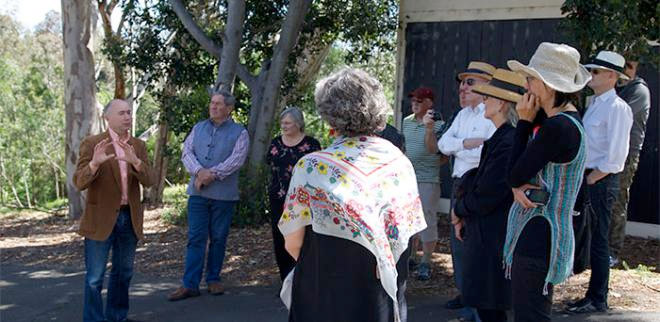Supporter Bus Tour
An eager bus load departed the University of Melbourne on Saturday 5th of October, but it wasn't filled with students off on a travelling studio or field trip. This bus was filled with some of the leading minds in Australia's built environment. ABP's advancement team, led by Judy Turner, welcomed 17 Faculty Alumni and supporters, and with the assistance of Associate Professor Jeffrey Turnbull and Professor Philip Goad, brought them on a tour of some of the most spectacular buildings and spaces in Melbourne.

Suzanne Dance, from the Class of 1965 tells us of her experience on the first, but hopefully not last, ABP Bus Tour.
"What better way to spend a sunny Saturday in October than visiting two of Australia's foremost buildings with a commentary provided by two of the country's finest Architectural Historians?"
The tour began at Newman College [1916-18] where a group of M.U Architecture Alumni assembled to meet our guide, Dr Jeffrey Turnbull, a noted college expert.
From visiting during my student days, I remember being transfixed by the contrasting compressed and soaring spaces and the subtle use of light, but with Dr Turnbull's encyclopaedic knowledge, our understanding of this masterpiece was immeasurably expanded. It was such a pleasure to see the Architect's vision manifest to an extent that rarely happens today, in the joinery, hardware details, not to mention the furniture.
Over morning tea, Dr Turnbull captivated the group with a stylistic analysis of the building and a biography of the lives of the authors, Marion Mahoney and Walter Burley Griffin.
From Newman College we were taken by bus, via a garden lunch at café Apte in Heidelberg Rd, to Fairy Hills, where Professor Philip Goad introduced us to the Harold Desbrowe-Annear's McGeorge House [1910]. He discussed the superb site overlooking the junction of the Darebin and Yarra rivers, the Macgeorge milieu of likeminded neighbours, such as the Napier Wallers, the Burley Griffins, the Heidelberg School painters and, of course, Desbrowe-Annear. He used this quintessential example to demonstrate the environmental awareness characteristic of the Arts and Crafts movement, drawing our attention to the various passive climate control devices and the sliding wall panels which enabled an essentially open plan house to be enclosed for winter heat conservation.
Through Professor Goad's enthusiasm and sensitive eye we experienced the building's spatial delights and, as at Newman College, marvelled at the involvement of the architect in minute and inventive detail.
A bonus was a walk past houses by Chancellor and Patrick, Clerehan and Guilford Bell and Napier Waller.
My thanks to the Advancement team for their seamless organisation."